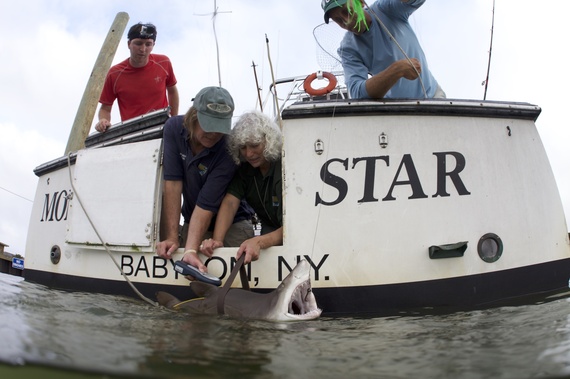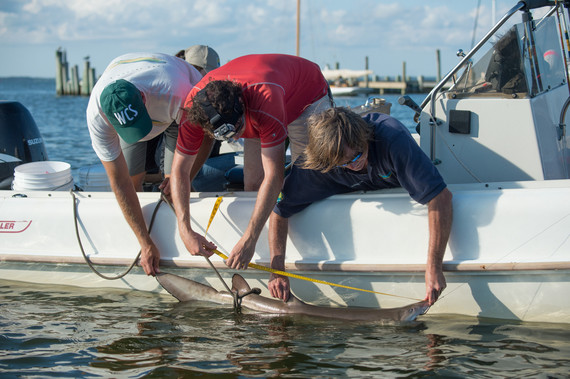It's spring time in New York City. Along with longer days and rising temperatures, many New Yorkers look forward to the arrival of migrating birds that grace the city's shorelines and parks, especially bird watchers eager to spot orioles, vireos, tanagers, and warblers as they pass through the area on their way north.
While the migratory movements of birds into the New York region are well known and enjoyed by thousands of nature lovers, another migration is underway beneath the surface of our coastal waters, as fish species also move along with the changing of the seasons. One such migratory species is the sand tiger shark, which is also a mainstay of the aquarium's exhibit collection, a fearsome looking fish that can grow up to 10 feet in length but which does not pose a threat to humans.
Every spring, juvenile sand tiger sharks, born earlier that year in coastal waters off South Carolina and further south, begin their seasonal migration northward to spend their summers in sheltered bays and coves from Delaware to Cape Cod, including within the New York Bight, the body of water between New Jersey's Cape May and the tip of Long Island.

Scientists and veterinarians working for WCS's New York Aquarium discovered a nursery ground for sand tiger sharks near shore waters of Long Island's Great South Bay. The discovery was made by researchers using acoustic tags. © Keith Ellenbogen
These baby sharks are the focus of a study on how this migratory species is using the marine habitats of our local seascape. Five years of research on the sand tiger shark in local waters recently resulted in big news: the discovery of a shark nursery in Long Island's Great South Bay. This finding was made possible through the use of state-of-the-art technology to follow the movements of marine species through their underwater environment.
For the past five years, scientists from the New York Aquarium have been applying acoustic "tags," or transmitters, to juvenile sand tiger sharks that inhabit Great South Bay for part of the year. The transmitters allow the scientists to follow the sharks' movements. The scientists can now record the movements of these animals using a network of acoustic receivers in the bay, gathering valuable data on how juvenile sharks use coastal habitats.
A big moment in this research was the discovery that a number of the sharks fitted with acoustic tags from previous years had returned to the bay. This behavior known as "site fidelity" provides us with a key insight into the life history of sand tiger sharks, particularly the juvenile fish that repeatedly return to the productive habitat safe from larger predators places like Great South Bay.
This is important information for learning how to protect this species, which has been impacted by over fishing in the past and is currently listed as a "Species of Concern" in U.S. waters. While the sand tiger shark has been protected from commercial and recreational fishing in US waters since 1997, the Great South Bay is not protected, and juvenile sharks are still susceptible to human development and activities that take place alongside these vulnerable fish.
The New York Aquarium and its New York Seascape conservation program are focused on protecting other marine species and natural wonders hidden by the productive waters off our coast. Farther afield, our scientists are using satellite tags to follow the movements of other sharks--the blue shark and the shortfin mako shark--as they move through their open ocean environment.

Data gathered from the sharks' movements are helping scientists learn more about the migratory behavior of sand tiger sharks and their habitat needs. Julie Larsen Maher ©WCS
Perhaps the biggest unseen wonder of New York Bight lies on the edge of the continental shelf. Located approximately 100 miles from New York City and some hundreds of feet below the ocean's surface lies the Hudson Canyon, an underwater colossus comparable in size to the Grand Canyon and home to deep sea corals and other marine species.
One of the primary goals of the New York Aquarium's local conservation efforts will be to better understand and raise awareness about this massive marine habitat lying on the doorstep of the United States' largest city. Moving through this magnificent seascape on an annual basis are not only sharks and many other marine fishes, but whales, dolphins, seals, and sea turtles.
The seasonal arrival of migratory fish into the waters of the New York Bight represents a significant, positive change for the better in waters that were once so polluted that they seemed synonymous with ecological disaster. Aquarium scientists and staff are working to conserve habitat and build greater awareness of migratory sharks and other marine wildlife in our waters so that these underwater arrivals may become as symbolic of spring's renewal as the seasonal passage of birds and flush of blooming flowers.
As we continue to advocate for effective ocean planning, where energy development, fishing, and shipping work in concert with the goals of conservation, the return of sand tiger sharks to Great South Bay remains a sign of environmental resilience and a healthy marine ecosystem that benefits all New Yorkers.